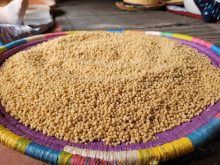Durum has recaptured its traditional premium over spring wheat and that relationship will likely remain intact until winter, says an analyst.
The crop was selling at about a $15 per tonne discount to spring wheat one month ago. Last week it was fetching a $20 per tonne premium.
“The spread has moved fairly dramatically,” said Bruce Burnett, CWB weather and crop specialist.
The main reason for the flip-flop is the reopening of the eastern transportation corridor, which was closed for an unusually long time due to the late thaw of the Great Lakes.
Read Also

Critical growing season is ahead for soybeans
What the weather turns out to be in the United States is going to have a significant impact on Canadian producers’ prices
That has allowed exporters to reach key durum markets in North Africa and southern Europe, where demand for the crop has been strong.
Those regions are busy harvesting their own durum crops but they need imports to supplement domestic production.
Burnett said North Africa’s crop was looking terrific due to plentiful moisture in the December through February period but there was a hot and dry finish to the growing season that hurt prospects.
“What looked to be an above average crop in late March turned into a crop that is probably closer to average,” he said.
Other important production regions in the Middle East like Turkey and Syria were hit hard by drought. Burnett expects Turkey to import more than it usually does in 2014.
Durum exports have been good in 2013-14 compared to other crops. Exporters shipped 3.04 million tonnes in the first eight months of the crop year, up slightly from the 2.87 million tonnes for the same period the previous year.
Sales to the United States have been particularly strong at 515,319 tonnes, up 70 percent from a year ago.
Burnett said that is due to a poor 2013-14 U.S. durum crop. Growers harvested 1.69 million tonnes, down 25 percent from the previous year. That drove up prices south of the border compared to Canadian bids that were depressed due to the transportation problems.
Most of Canada’s durum is grown “within spitting distance” of the U.S. border, so trucking it to U.S. elevators and mills is feasible.
Exports to Italy were up 58 percent to 553,952 tonnes for the first eight months.
Sales to Tunisia rose 142 percent to 183,655 tonnes and shipments to Morocco were up four percent to 550,727 tonnes.
Algeria is the only major customer where sales fell, down 46 percent to 249,204 tonnes, although there have been reports that the country recently purchased 200,000 to 250,000 tonnes of durum, the largest portion of which will be supplied by Canada.
The strong export program is ex-pected to result in 2.3 million tonnes of carryout, which while higher than normal isn’t overly burdensome, said Burnett.
Agriculture Canada’s estimate is an even more manageable 2.1 million tonnes.
It is not as worrisome as the anticipated record 3.25 million tonnes of canola or the 9.3 million tonnes of wheat, which is the highest carryout of that commodity in decades.
Burnett expects strong demand for durum will keep the premium in place until the St. Lawrence Seaway freezes over in winter.
“Even if exports do tail off a little bit after the initial surge I feel the strong demand is going to keep on trying to pull durum out this year,” he said.
He is forecasting 1.8 million tonnes of ending stocks in 2014-15, which would be back to fairly typical levels.
Durum planting in Western Canada is complete and most growers managed to seed their intended acres in a timely fashion because the durum growing area isn’t where the real wet spots were this spring.
“The prospects are looking pretty good right now,” said Burnett.


















